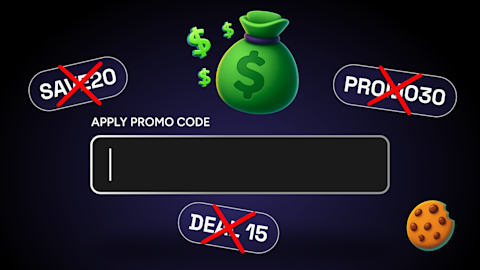Alternative metals like titanium and tungsten cost 70-80% less than gold or platinum while offering superior durability
Shopping online can save you 30-50% compared to traditional jewelry stores due to lower overhead costs
Choosing 10k or 14k gold instead of 18k can cut your ring cost nearly in half without sacrificing quality
The "right" time to buy matters—retailers offer the deepest discounts during Black Friday and Valentine's Day sales
Custom engraving typically adds only $25-$100 to your total cost, making personalization surprisingly affordable
Wedding planning comes with enough sticker shock without your ring adding to the stress. While the average US person shells out between $350 and $600 for a wedding band, what most don't realize is that the wedding jewelry industry operates on massive markups—sometimes 200-300% over actual material costs.
The good news? Understanding how wedding band pricing actually works gives you serious leverage to find a ring that fits both your style and your budget without compromising on quality.
Here's what makes the wedding band market particularly interesting right now: there's been a major shift toward alternative metals that cost a fraction of traditional options. Titanium and tungsten rings that would have seemed unconventional just a few years ago are now mainstream choices, offering modern styling and unmatched durability at price points starting around $100. Meanwhile, traditional precious metals like gold and platinum still dominate the market for those willing to spend $800-$2,000+, but even here, strategic choices about karat weight and where you shop can translate to hundreds in savings.
Ready to find the perfect ring without overpaying? Get today's verified wedding band promo codes from top jewelry retailers.
What actually determines how much you'll pay for a wedding band
The markup game in wedding jewelry is more aggressive than most industries. Chain jewelry stores routinely mark up gold rings by 327-466% above the actual gold value, while luxury brands like Tiffany push markups to a staggering 475%. Understanding what drives these costs—and where the wiggle room exists—gives you the leverage to negotiate or shop smarter.
Material is 60-70% of your total cost
The metal you choose isn't just about aesthetics or durability—it's the single biggest factor in your ring's price tag. Here's why — precious metals like gold and platinum are priced by weight and purity, meaning a heavier ring in a higher karat will cost exponentially more. Alternative metals like titanium and tungsten have negligible raw material costs (hence their $100-$300 price points), but retailers still apply 100-250% markups for design and branding.
The real insider knowledge? Direct-to-consumer online brands typically markup only 42-94% above gold value, compared to 180-466% at mall retailers. That difference alone can save you $200-$500 on an identical basic band.
Weight and width create exponential price jumps
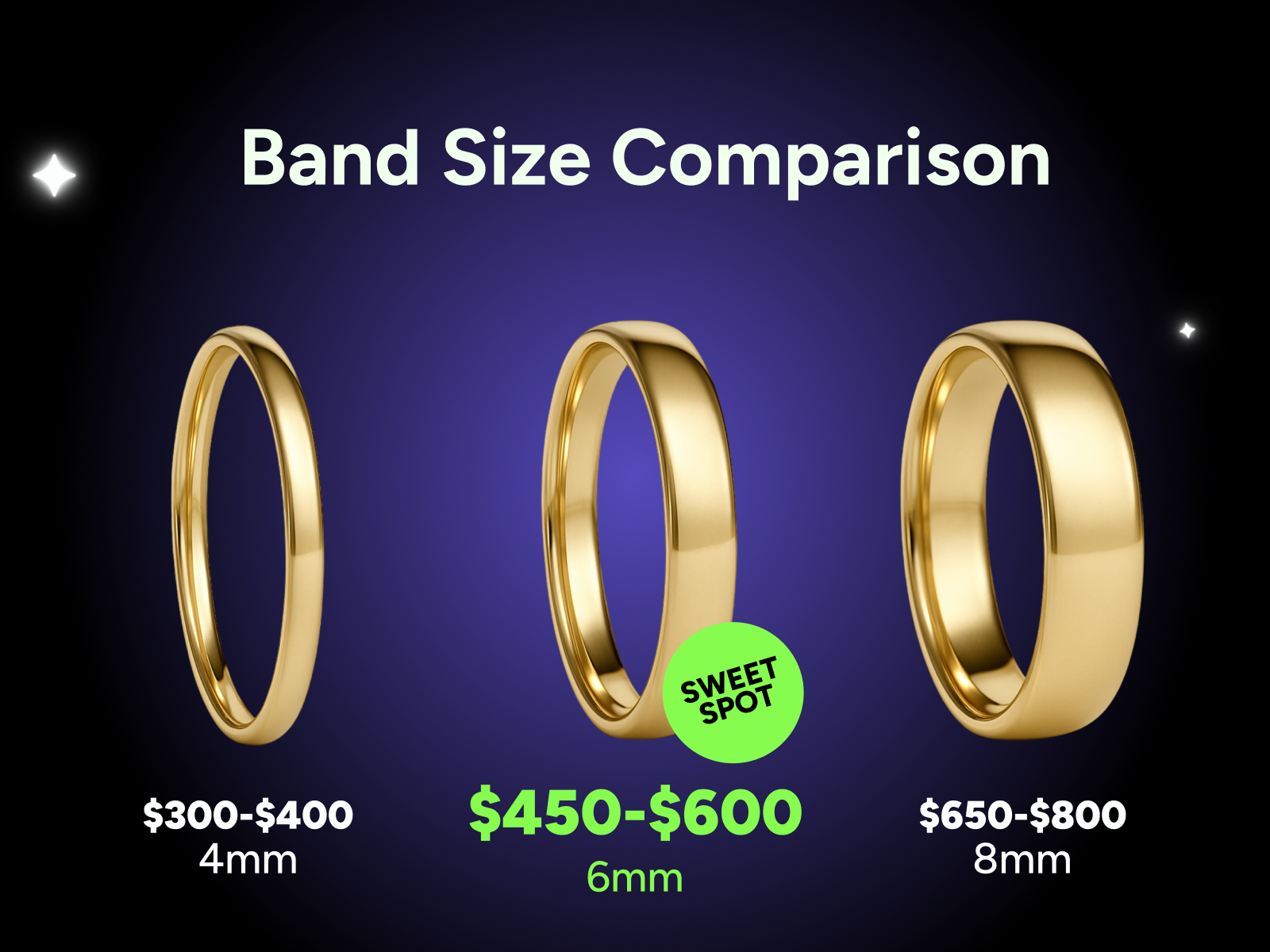
Many don't realize that band width isn't just a style choice—it's a major cost driver. Moving from a 4mm to an 8mm band nearly doubles the price because you're using roughly twice the metal. Here's what that looks like in real dollars for a 14k gold band:
Width | Typical price | Price increase |
4mm | $300-$400 | Baseline |
6mm | $450-$600 | +$150-$200 |
8mm | $650-$800 | +$250-$350 |
The savings strategy: Most people find 6mm perfectly comfortable and substantial-looking, saving $150-$350 compared to an 8mm band without sacrificing presence on the hand.
Gold karat choice can save you $200-$300
This is where many people overspend without realizing it. The difference between 10k, 14k, and 18k gold comes down to purity:
10k gold = 41.7% pure gold, rest is alloy (harder, more durable, less yellow)
14k gold = 58.3% pure gold (sweet spot for durability and appearance)
18k gold = 75% pure gold (softer, more prone to scratches, deepest yellow color)
For a typical band weighing 5-7 grams, here's the price breakdown:
18k: $750-$1,000
14k: $550-$700 (save $200-$300 vs 18k)
10k: $300-$400 (save $150-$250vs 14k)
Most jewelers will push 18k as "premium," but here's the truth, according to experts, “14K Gold Wedding Bands have the most resistance to wear and tear, making it a popular choice among most couples.”
The extra hardness from alloy metals actually makes it more practical for everyday wear, especially if you work with your hands.
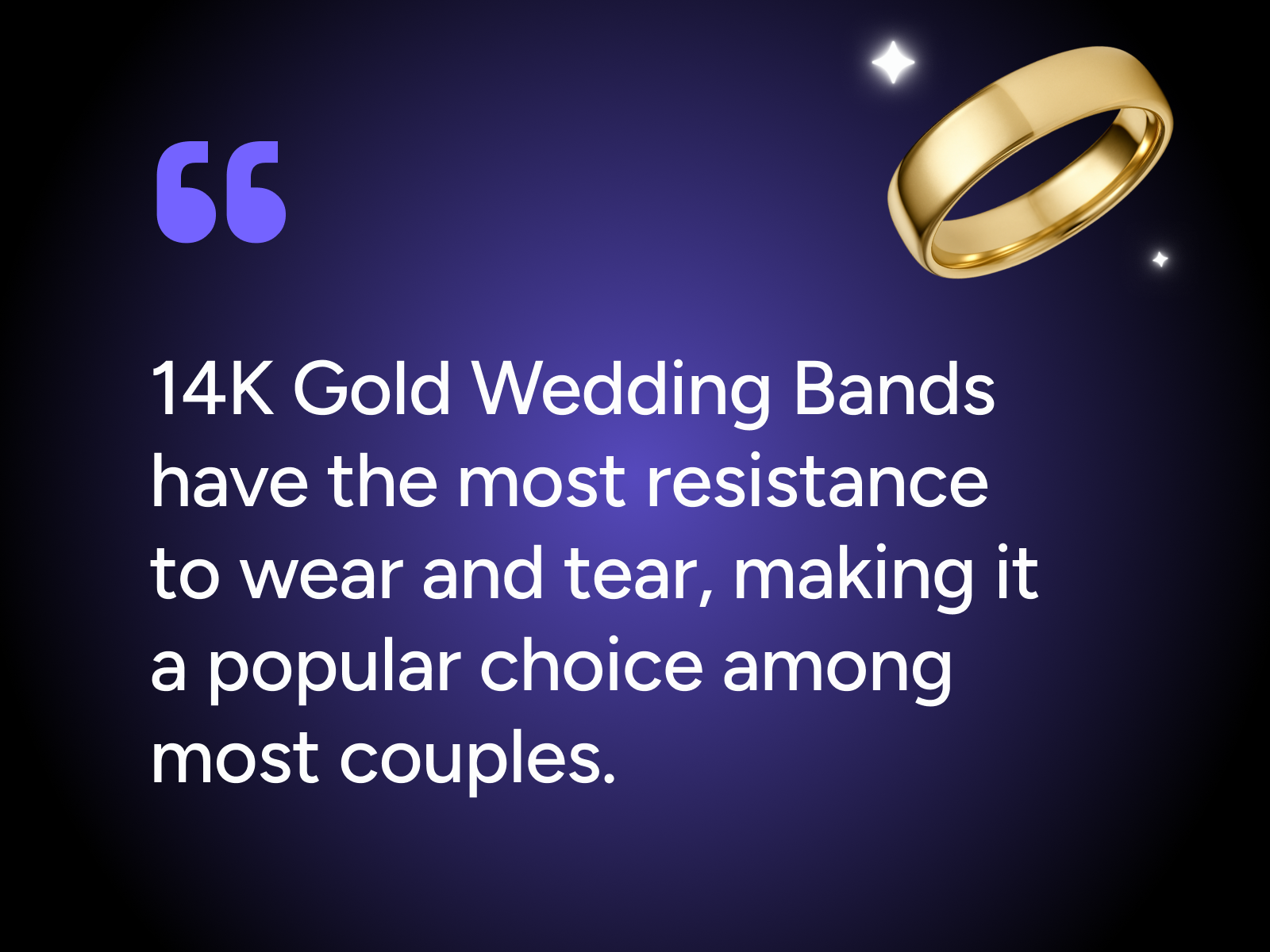
Brand names add 200-475% to identical rings
Designer brands command massive premiums for the same materials. A Tiffany 18k gold band carries a 475% markup, while mainstream retailers like Zales mark up 327-466%. Meanwhile, direct-to-consumer online specialists operate at 42-94% markups—transparent pricing that reveals how much you're really paying for a logo.
The strategy: For plain or classic designs, skip the designer name entirely. You're paying hundreds for branding on a ring that doesn't display logos anyway. Save the splurge for unique custom work where design expertise actually matters.
Customization costs less than you'd expect
One of the biggest surprises in wedding band pricing is how affordable personalization actually is:
Basic engraving: $40-$75 online, though retail jewelers charge $80-$150
Custom design work (unique shapes, mixed metals): $100-$400 extra
Adding small accent diamonds: Starts at $150-$300, increasing total cost by 30-60% for channel-set stones
Many online retailers include free engraving with purchase, turning a perceived premium feature into a standard benefit.
The in-store markup vs online pricing gap
The channel where you buy determines how much you'll pay more than almost any other factor. Here's a real-world comparison for a standard 14k gold 6mm band:
Retailer type | Typical price | Markup % | Notes |
Luxury (Tiffany, Cartier) | $1,200-$2,000+ | 350-475% | Highest brand premium |
Chain Store (Zales, Kay) | $550-$800 | 180-466% | Aggressive upselling tactics |
Discount Retail (Costco) | $250-$500 | 55-142% | Limited styles, best for plain bands |
Online Direct Brands | $250-$450 | 42-94% | Price transparency, free engraving common |
Breaking down wedding band costs by metal type
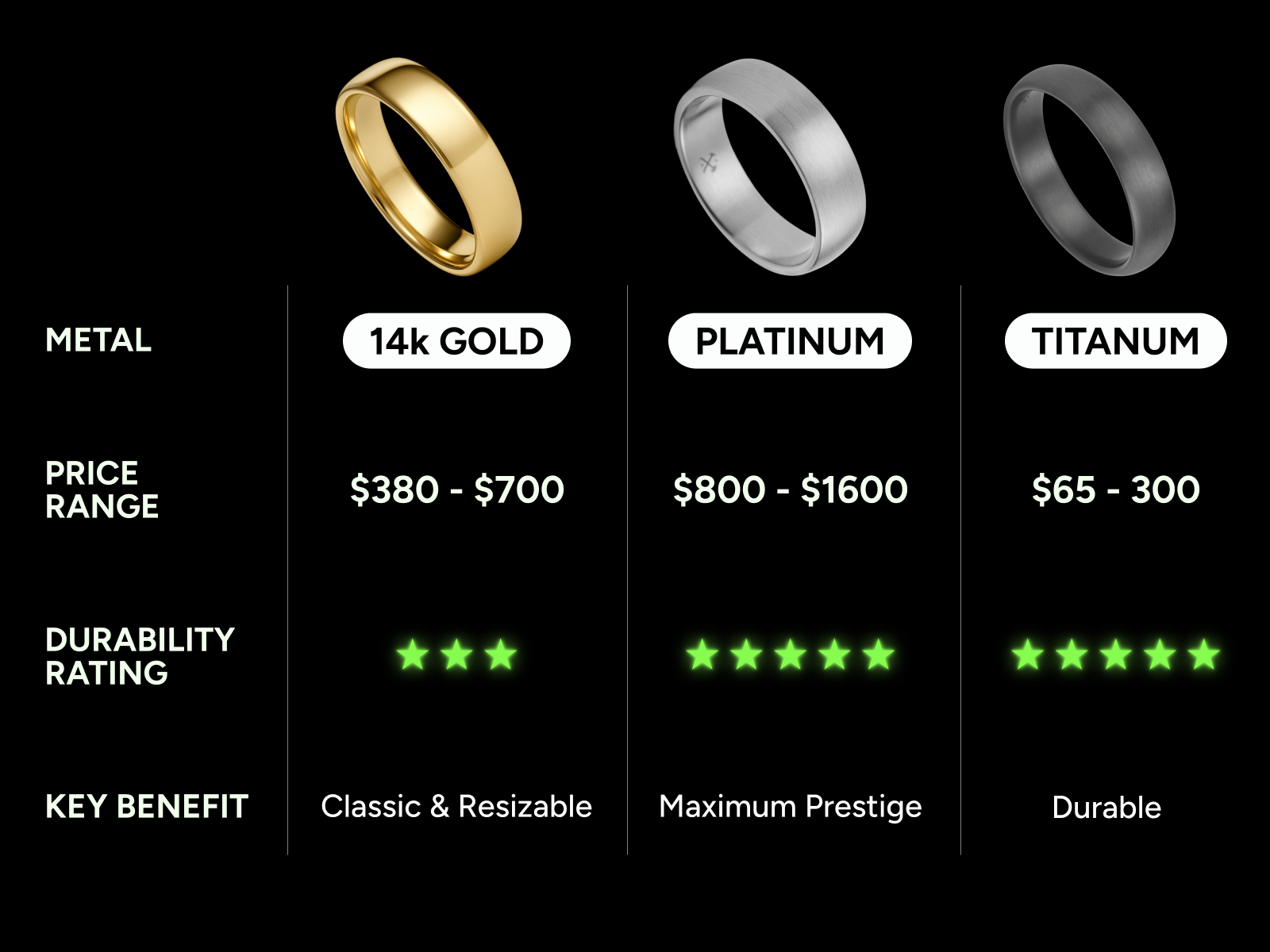
The metal you choose determines not just the upfront cost, but also long-term expenses like maintenance, repairs, and whether you'll need to replace the ring entirely if your size changes. Here's what you're actually paying for with each option—and where the smart money goes in 2025.
Gold: The classic choice with hidden maintenance costs
Gold remains the traditional standard, but the karat level you choose creates dramatic price differences that most jewelers won't explain clearly upfront.
10k gold: $250-$400
The most affordable gold option at 41.7% purity, 10k gold offers surprising durability due to its higher alloy content. While purists may dismiss it as "less authentic," the practical reality is that 10k gold scratches less easily than higher karats and costs $130-$300 less than 14k for an identical design.
The catch: The color is noticeably paler than 14k or 18k, which matters if you're set on that rich yellow gold look.
Example pricing: JustMensRings 10k 6mm comfort fit: $359
14k gold: $380-$700
This is the sweet spot that most jewelers recommend for a reason—58.3% gold content provides excellent durability while maintaining a rich color. The 14k middle ground means you're not overpaying for purity you don't need (18k) but still getting genuine precious metal quality.
Hidden costs: If you choose white gold, budget $60-$120 every 1-2 years for rhodium re-plating to maintain that bright white finish. Yellow and rose gold skip this expense entirely.
Example pricing: Blue Nile 14k 6mm comfort fit: $585
18k gold: $600-$1,200+
At 75% gold purity, 18k delivers the richest color and highest prestige—but you're paying a premium for softness that makes the ring more prone to scratches and dents. Unless you have a specific reason to want maximum gold content (investment value, cultural significance, or that ultra-rich color), 14k offers better practical value.
The reality check: You're spending $220-$500 more than 14k for a ring that will show more wear over time.
Example pricing: Blue Nile 18k 6mm: $1,000+
Platinum: Maximum prestige at maximum cost
Price range: $800-$1,600 (simple band), $1,400-$2,500 (designer)
Platinum commands the highest prices among traditional metals, but you're paying for genuine advantages: it's naturally hypoallergenic, incredibly dense (which creates that substantial feel), and never requires plating like white gold does. The white color is permanent and won't fade or yellow over time.
The hidden cost trap: While platinum doesn't need rhodium plating, it does develop a matte "patina" of tiny scratches that some people love and others hate. Polishing it back to high shine costs $80-$150, and resizing runs $100-$200 due to the difficulty of working with such dense metal.
Example pricing: Blue Nile 6mm platinum comfort fit: $1,340 | Robbins Brothers: $1,495
Value verdict: Platinum makes sense if you want the absolute best in durability and prestige and plan to wear the same ring forever. For everyone else, 14k white gold or palladium offers similar aesthetics at significantly lower costs.
Palladium: Platinum's lighter, cheaper cousin
Price range: $600-$1,200
Palladium delivers about 60% of platinum's pricing while maintaining the same naturally white color, hypoallergenic properties, and low maintenance benefits. The main difference? It's noticeably lighter weight, which some prefer and others find less substantial.
The availability problem: Palladium rings are harder to find in typical jewelry stores, limiting your style options compared to gold or platinum.
Example pricing: Shane Co. 5mm palladium: $790
Titanium: Maximum durability at minimum cost
Price range: $65-$300
Here's where the value equation flips entirely. Titanium costs a fraction of precious metals while offering superior scratch resistance, zero rust or tarnish, and hypoallergenic properties. It's the go-to choice for people in active careers or those who prioritize practicality over tradition.
The major tradeoff: Titanium cannot be resized. If your finger size changes, you're buying a new ring. For some, this is actually a feature—it means you can own multiple affordable titanium rings in different styles for under $600 total.
Example pricing: Blue Nile classic 6mm: $125 | Modern Gents 8mm: $195
Best value scenario: If you're confident about your ring size and want a "wear and forget" ring that will still look new in 10 years, titanium offers unbeatable value.
Tungsten: Scratch-proof but brittle
Price range: $70-$300 (simple), $200-$400 (inlay designs)
Tungsten delivers extreme hardness at budget-friendly prices, making it nearly impossible to scratch in daily wear. The substantial weight feels similar to platinum, which appeals to people who want that premium heft without the $1,500 price tag.
The brittleness problem: While tungsten won't scratch, it can shatter if you slam it hard against concrete or drop it at exactly the wrong angle. It also cannot be resized, meaning any size change requires full replacement.
Example pricing: Modern Gents black 8mm: $180 | Larson Jewelers 8mm: $167
Cobalt: The underrated middle ground
Price range: $130-$350 (standard), $480-$550 (gold inlay)
Cobalt offers the best of multiple worlds: it's naturally white like platinum, hypoallergenic, extremely scratch-resistant, and costs less than gold while feeling weightier than titanium. The main reason it's not more popular is simply lack of awareness—most have never heard of it.
The sizing limitation: Some jewelers can resize cobalt, but many can't or won't, making it similar to titanium in that regard.
Example pricing: Tungsten Rings Co. Ares 6mm: $225 | Zeus with gold inlay: $489
Value verdict: For those who want a white metal aesthetic, hypoallergenic properties, and serious durability without platinum pricing, cobalt is an exceptional value that deserves more attention.
Alternative materials: Budget-friendly or backup rings
Price ranges:
Stainless steel: $50-$150
Carbon fiber: $70-$200
Ceramic: $50-$250
Silicone: $20-$45
These materials serve two distinct purposes: ultra-budget primary rings or practical backup rings for those who work with their hands, travel frequently, or participate in activities where losing or damaging a precious metal ring is likely.
Example pricing: Modern Gents carbon fiber 8mm: $175 | Silicone: $36
Strategy: Many now buy a traditional precious metal ring for formal occasions and one or more alternative material rings for daily wear, keeping their $500+ investment safe while still wearing their wedding band everywhere.
Which metals offer the best value in 2025?
After analyzing hundreds of rings across price points, three clear value winners emerge:
14k gold ($380-$700): The best balance of tradition, durability, resizability, and long-term value among precious metals. Easy to repair, widely available, and holds resale value.
Titanium ($65-$300): Unbeatable for pure durability-to-cost ratio. Perfect for active lifestyles, though the no-resize limitation requires confidence in your size.
Cobalt ($130-$350): The hidden gem offering platinum aesthetics and durability at one-third the cost, with hypoallergenic benefits that gold can't match.
Avoid overpaying for: 18k gold (unless you specifically want maximum purity), platinum (unless prestige matters more than budget), and designer brands on simple designs (you're paying 300-475% markup for a logo nobody will see).
The hidden cost nobody mentions: maintenance and repairs
When comparing metals, most focus solely on purchase price and miss the long-term expense differences:
Metal | Resizing cost | Maintenance | Replacement risk |
Gold (14k/18k) | $50-$150 | Rhodium plating (white): $60-$120 every 1-2 years | Low |
Platinum | $100-$200 | Polishing: $80-$150 as needed | Low |
Palladium | $100-$200 | Minimal | Low |
Titanium | Cannot resize | None | Medium (if size changes) |
Tungsten | Cannot resize | None | Medium (can shatter) |
Cobalt | Limited availability | Minimal | Low-Medium |
The 10-year cost reality: A $1,400 platinum ring plus $600 in maintenance/polishing = $2,000 total. A $585 14k white gold ring plus $720 in rhodium plating = $1,305 total. A $125 titanium ring replaced once = $250 total.
Understanding these long-term costs often changes which metal makes the most financial sense for your specific situation.
The real cost of customization: where to splurge and where to save
Most assume customization means expensive, but the reality is more nuanced. Some personalization options cost almost nothing and add genuine value, while others triple your ring's price for features you'll rarely notice. Here's how to navigate customization costs strategically.
Engraving: surprisingly affordable (if you shop smart)
The price gap between online and in-store engraving is one of the most dramatic markups in wedding jewelry. Basic inside engraving costs $25-$60 online but jumps to $60-$120 at mall jewelry stores for identical machine work. That's a 100-150% markup for the exact same service.
What different engraving types actually cost:
Basic text engraving (inside band, machine):
Online retailers: $25-$60
Chain stores: $60-$120
Example: Blue Nile charges $35, while Shane Co. runs $70-$90
Dates, coordinates, or initials: $30-$70 (similar to basic text unless you want unusual fonts)
Symbols and special characters: $35-$90 depending on complexity (hearts, ampersands, religious symbols)
Outside band engraving: Add $20-$50 to base price since visible engraving requires more precision work
Hand engraving by artisans: $150-$400 for intricate work like floral patterns, family crests, or detailed motifs
The insider move: Many large online retailers now include free standard inside engraving with purchase. Modern Gents, Blue Nile, and JustMensRings regularly offer this, turning a $60-$120 expense into a $0 bonus. Always ask about free engraving before paying extra.
Custom design work: from minor tweaks to complete originals
Custom design exists on a spectrum, and understanding where your idea falls determines whether you'll pay $100 or $2,000.
Minor modifications and finish changes: $50-$150
Simple customizations like adding texture, switching to a matte finish, or creating a two-tone effect typically cost under $150 online. These changes deliver high visual impact for modest investment, making them some of the best value customizations available.
Semi-custom designs: $200-$550
This middle ground involves reworking an existing stock design—maybe adjusting the width, adding a subtle pattern, or mixing metals. You're not starting from scratch, which keeps costs reasonable while still getting something unique.
Fully custom rings: $750-$2,000+
When you want a completely original design created specifically for you, expect to pay serious money. The typical "from-scratch" custom band at a mid-tier jeweler runs around $1,200, though this can escalate quickly with complex designs or premium materials.
Real examples:
Diamond District NYC custom 6mm gold band: $1,100
Brilliant Earth fully custom two-tone design: $1,500 starting point
Local artisan jewelers: $1,500-$2,500 for intricate handmade pieces
Value reality check: Full custom work makes sense when you have a specific vision that doesn't exist anywhere else. For most, though, semi-custom modifications to existing designs deliver 80% of the uniqueness at 30% of the cost.
Adding diamonds or gemstones: the fastest way to double your budget
Stones transform pricing more dramatically than any other customization. Even small accent diamonds can add hundreds to your total, while full eternity bands routinely double or triple base ring costs.
Tiny accent stones (under 0.05 carats, flush or channel-set):
Online: $75-$200 per stone
In-store: $200+ per stone
Small side or center stones (0.10-0.25 carats):
Prong or bezel setting: $250-$500 per stone
Channel setting for accent row:
Typical cost: $300-$900 for a single row of small diamonds
Prong setting for multiple accents:
$400-$1,200 depending on number and size of stones
Full eternity style (stones completely around the band):
Price range: $850-$2,500+
The catch: Full eternity bands cost significantly more and complicate future resizing
Strategic approach: Most find that 3-5 small accent stones provide plenty of visual interest at $300-$600 total, while full eternity designs that cost $1,500+ offer diminishing returns for everyday wear. The exception is if you want maximum sparkle and rarely expect to resize.
Online vs in-store: the customization price gap
The customization markup at physical stores follows the same pattern as base ring pricing—you're paying for overhead, sales commissions, and retail space.
Customization type | Online price | In-store price | Savings online |
Text engraving | $25-$60 | $60-$120 | 50-100% |
Custom finish (minor) | $50-$150 | $150-$400 | 60-170% |
Full custom ring | $600-$1,200 | $1,000-$2,000 | 40-70% |
Add diamond/stone | $100-$300/stone | $250-$500/stone | 60-150% |
The tradeoff: Shopping online for customization means you can't see the work in person until it arrives, though most reputable retailers offer detailed photos throughout the process and generous return policies.
Which customizations offer the best value?
After analyzing hundreds of custom rings, three clear winners emerge for the value-conscious:
1. Free inside engraving (actual value: $60-$120) Many online retailers include this at no charge. It adds genuine sentimental value and costs you nothing. Always take advantage of free engraving offers.
2. Semi-custom finishes ($50-$200) Matte, hammered, brushed, or two-tone finishes create distinctive looks for minimal upcharge. The visual impact far exceeds the modest price increase.
3. 3-5 small accent stones ($300-$600 total) If you want diamonds, a few accent stones deliver the sparkle without the extreme cost of full eternity bands. Channel setting keeps them secure and low-profile.
Which customizations are overpriced?
Hand engraving on mass-produced bands Paying $150-$400 for hand engraving makes sense on a custom or heirloom ring, but on a $300 mass-produced band? You're spending more on engraving than the ring itself.
Outside band engravings at designer retailers The same machine engraving that costs $35 online runs $100-$200 at luxury jewelers, purely for the brand name.
Full eternity diamond bands for daily wear These routinely double your ring cost ($850-$2,500+) and create practical problems: they can't be resized easily, and the constant stone contact means higher snag risk. Unless you specifically want maximum sparkle and understand the limitations, partial diamond accents offer better value.
Retailer-specific customization pricing examples
Understanding what different retailers actually charge helps you compare intelligently:
Basic engraving: $35
Custom finishes: $50-$120
Adding diamonds: $120-$600 per stone depending on size and setting
Machine engraving: $70-$90
Full custom designs: $400+ starting point
Engraving: $40+
Custom band designs: $1,250+ for substantial modifications
Standard engraving: FREE
Special engraving requests: $25-$75
The bottom line on customization: Smart customization adds personality and value without breaking your budget. Prioritize free or low-cost options like included engraving and finish selection, consider 3-5 accent stones if you want sparkle, and reserve fully custom work for when you have a truly unique vision that justifies the $1,200+ investment.
Where to shop for wedding bands?
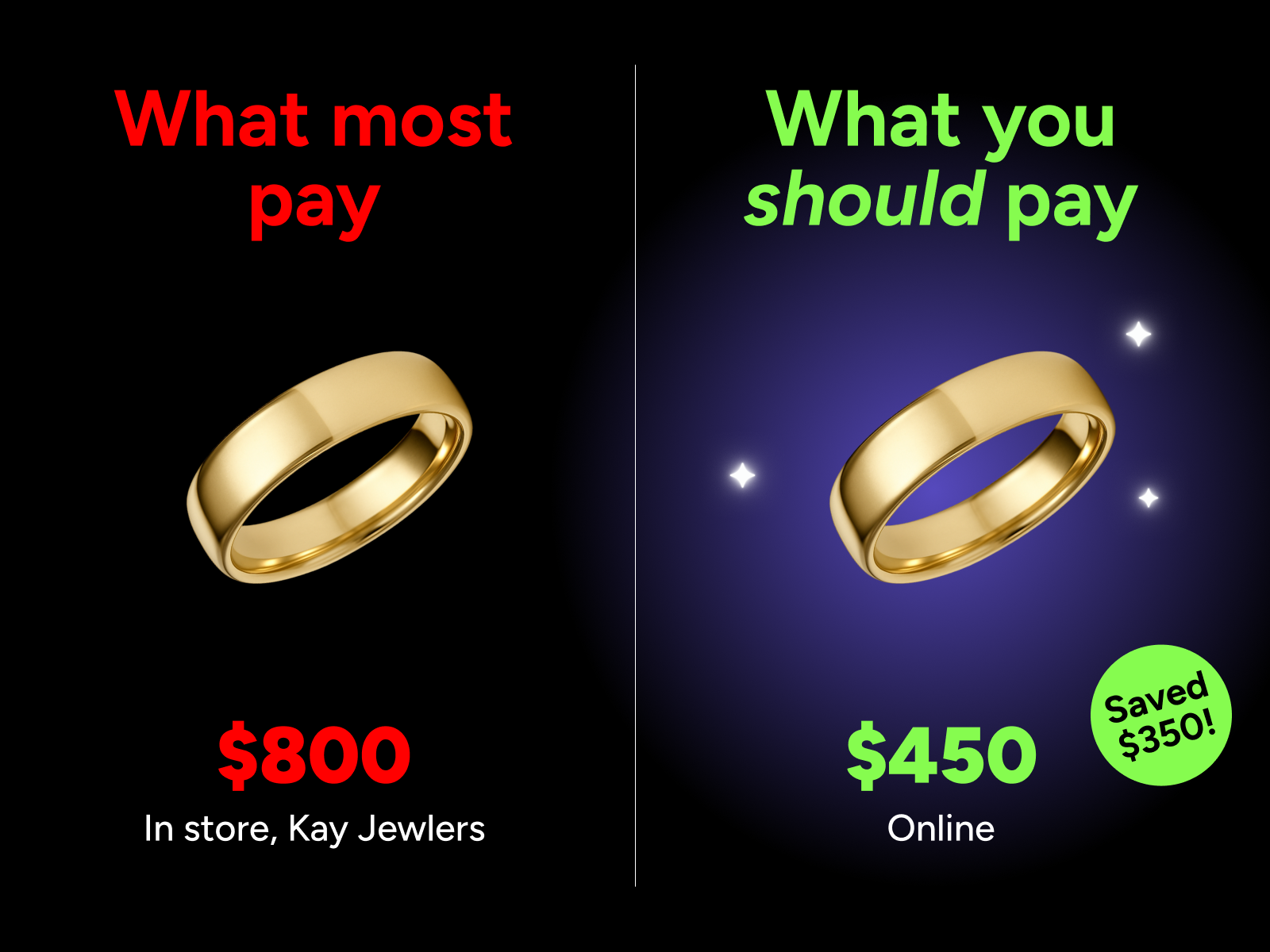
The retailer you choose determines your final price almost as much as the ring itself. Shopping at online specialists instead of mall jewelry stores can save you $200-$500 on identical rings, while strategic timing around major sales events adds another 20-40% in savings. Here's how to navigate the buying landscape like an insider.
Understanding your purchase options: the real pros and cons
Each retail channel comes with distinct advantages and tradeoffs that go beyond simple pricing differences.
Jewelry store chains (Jared, Kay, Zales)
Typical pricing: 14k gold 6mm band runs $550-$800
Pros: You can try rings on in person, get immediate sizing help, and walk out with your purchase the same day. These chains offer the full jewelry store experience with professional staff and in-house repair services.
Cons: This is where markups hit 180-466% above gold value. Sales associates work on commission, which means aggressive upselling is standard practice. You're paying for the mall location, staffing costs, and shareholder profits.
Best for: People who absolutely need to try on rings in person and value immediate availability over price optimization.
Luxury retailers (Tiffany, Cartier)
Typical pricing: 14k gold 6mm band runs $1,200-$2,000+
Pros: Maximum prestige, impeccable craftsmanship, superior presentation, and the brand cachet if that matters to you.
Cons: You're paying 350-475% markups for a brand name on a ring that doesn't display logos. For simple designs, the quality difference versus $600 rings is negligible.
Best for: Unlimited budgets or those who specifically value luxury brand heritage.
Independent local jewelers
Typical pricing: 14k gold 6mm band runs $480-$780 (negotiable)
Pros: Personal service, easy negotiation leverage, custom work expertise, and often the best option for complex sizing or repairs. These jewelers can typically beat chain store prices when you negotiate.
Cons: Selection is smaller, pricing varies widely between jewelers, and custom work can be pricey depending on the craftsperson's reputation.
Best for: Custom designs, unusual sizing needs, or shoppers who enjoy negotiating and building relationships with local businesses.
Online specialists (Blue Nile, Brilliant Earth, Modern Gents, Marke)
Typical pricing: 14k gold 6mm band runs $250-$585
Pros: This is where the best value lives. Direct-to-consumer models eliminate retail markup, resulting in 30-50% lower prices than mall stores. Most include free engraving, free shipping, and generous return policies. Blue Nile charges $585 for a ring that costs $800 at Kay Jewelers.
Cons: You can't try the ring on before buying, though many now offer home try-on programs. Returns require shipping back and waiting for refunds.
Best for: Value-conscious shoppers comfortable with online purchases. This is where you'll find the lowest prices on quality rings.
Specific example: Marke offers US-made 14k gold bands starting at $280 with free home try-on—that's half the price of chain stores for comparable quality.
Big-box retailers (Costco, Walmart)
Typical pricing: 14k gold 6mm band runs $250-$580
Pros: Lowest prices on basic designs, hassle-free returns with membership guarantees, and surprising quality for simple bands. Costco jewelry often undercuts everyone else by 30-40%.
Cons: Style selection is extremely limited, packaging is basic, and staff expertise is minimal. You won't find trendy designs or extensive customization options.
Best for: Budget-conscious grooms who want simple, traditional styles and prioritize savings over selection.
Amazon
Typical pricing: 14k gold 6mm band runs $250-$650
Pros: Ultimate convenience, fast Prime shipping, easy returns, and rock-bottom prices on alternative metals. Thousands of style options.
Cons: Quality is wildly inconsistent. You must carefully vet sellers, verify metal authenticity claims, and accept that warranties may be limited. The jewelry category on Amazon has significant counterfeiting issues.
Best for: Alternative metal rings (titanium, tungsten) from established sellers, or shoppers willing to thoroughly research seller ratings and return policies.
Real price comparisons: the same ring at different retailers
To illustrate just how much pricing varies, here's what you'd pay for essentially the same 14k gold 6mm comfort fit band across different channels in October 2025:
Retailer | Price | What you're paying for |
Marke (online) | $280 | Direct-to-consumer efficiency |
Blue Nile (online) | $585 | Established online brand + free services |
Costco (big-box) | $399-$580 | Wholesale buying power |
Macy's (chain) | $799+ | Department store overhead + brand |
Tiffany & Co. (luxury) | $1,700+ | Maximum brand prestige |
Local independent jeweler | $480-$780 | Personal service + negotiable |
The savings math: Buying from Marke instead of Tiffany saves you $1,420 on functionally identical rings. Even compared to Macy's, you'd save $519—enough to cover engraving, a backup titanium ring, and a nice dinner.
Price matching: which retailers actually honor it
Not all price match policies are created equal. Here's what actually works:
Jared, Kay, Zales: Generally honor local competitor prices and some online advertised prices. Bring printed proof from a legitimate retailer. They'll typically match within $50-$100 of the competitor's price.
Blue Nile, Mejuri: Offer price adjustments if their own price drops within 30 days of your purchase. They won't match competitors but will credit you if you bought at the wrong time.
Costco, Brilliant Earth: Rarely price match because their prices are already among the lowest. Their strategy is to lead with strong value rather than match after the fact.
Reality check: Price matching sounds great but often involves hassle and restrictions. Shopping at low-price retailers from the start usually beats trying to negotiate matches at expensive stores.
Buying used or vintage: viable strategy or risky gamble?
For gold and platinum bands, the used market offers legitimate 40-70% savings with minimal risk if you shop smart.
Where to find quality used rings:
eBay (with seller guarantees): Vast selection, strong buyer protection, but requires careful seller vetting
The RealReal: Authenticated luxury pieces, higher prices but guaranteed authenticity
Worthy: Auction platform for pre-owned jewelry with professional authentication
Local estate jewelers: Often the best deals, ability to inspect in person, negotiable pricing
What you'll pay: Expect 40-70% off retail for gold and platinum bands in good condition. A $800 ring sells for $320-$480 used.
The verification checklist:
Request proof of metal authenticity (markings, certificates)
Confirm sizing is possible (ask about metal type and thickness)
Budget $50-$75 for professional cleaning and minor refinishing
Check return policies—buy only from sellers who accept returns
Best candidates for buying used:
Simple gold or platinum bands (no complex inlays or technology)
Classic designs that don't look dated
Rings from verified luxury brands where authentication is straightforward
Skip used for:
Alternative metals (titanium, tungsten) that can't be refinished
Rings with unknown service history
Heavily customized designs where sizing is problematic
The best times to buy a wedding band: Sales calendar strategy
Jewelry retailers follow predictable sales cycles that create recurring opportunities for major discounts.
January-February: The absolute best buying window
Post-holiday and post-engagement season creates the deepest discounts as retailers clear inventory. You'll find 30-40% off at many stores, especially on online platforms. This is prime time for serious bargain hunters.
Black Friday/Cyber Monday: Up to 50% off
The biggest jewelry sales of the year, with discounts reaching 40-50% at online specialists like Blue Nile, Brilliant Earth, and Modern Gents. Mall chains offer 20-30% off during this period.
Strategy tip: Create wishlists in October, then buy during Black Friday weekend. Many retailers extend Cyber Monday deals through the entire week now.
Valentine's Day: Strong promotions with timing nuance
Expect 10-25% off, but here's the insider knowledge: prices often inflate slightly in the two weeks before Valentine's Day, then drop sharply the week after. Shop February 15-28 for the best deals.
July-August clearance: Under-the-radar savings
Retailers make room for new collections during summer, creating modest markdowns (15-25% off) that most shoppers miss because they're not watching jewelry sales in summer.
When NOT to buy: May-June
Wedding season peak means higher demand and fewer discounts. Retailers have no incentive to discount during their busiest months.
Your wedding band buying strategy
You don't need to spend $1,500 to get a quality ring you'll love for a lifetime, and you shouldn't settle for a $100 Amazon special that will tarnish or irritate your skin within a year. The real sweet spot is understanding what drives costs, shopping strategically to avoid massive markups, and investing in quality where it actually matters—durable materials, comfortable design, and meaningful personalization.
The wedding band market has never been more competitive or transparent than it is in 2025. Online specialists have forced traditional retailers to either compete on price or justify their premiums with genuine service value. Alternative metals have matured from novelty options to legitimate choices that deliver performance precious metals can't match. And information asymmetry—where jewelers knew everything and customers knew nothing—has collapsed thanks to resources like this guide.
Your wedding band should mark one of life's most significant commitments without creating financial stress that undermines the joy of that moment. By understanding what you're actually paying for, refusing to accept arbitrary markups, and focusing on long-term value rather than short-term prestige, you can find a ring that fits both your finger and your budget perfectly.
The best ring is the one you'll still be happy wearing 30 years from now—and that happiness has far more to do with thoughtful purchasing decisions today than the size of the price tag.

by Sean Fisher
AI Content Strategist · Demand.io
Sean Fisher is an AI Content Strategist at Demand.io, where he leads content initiatives and develops an overarching AI content strategy. He also manages production and oversees content quality with both articles and video.
Prior to joining Demand.io in September 2024, Sean served as a Junior Editor at GOBankingRates, where he pioneered the company's AI content program. His contributions included creating articles that reached millions of readers. Before that, he was a Copy Editor/Proofreader at WebMD, where he edited digital advertisements and medical articles. His work at WebMD provided him with a foundation in a detail-oriented, regulated field.
Sean holds a Bachelor's degree in Film and Media Studies with a minor in English from the University of California, Santa Barbara, and an Associate's degree in English from Orange Coast College.


